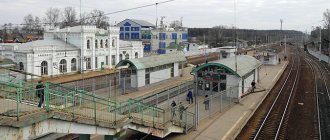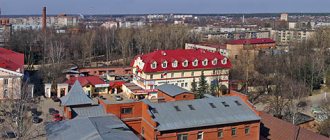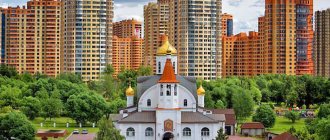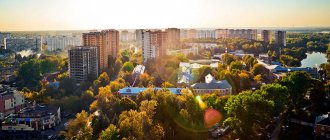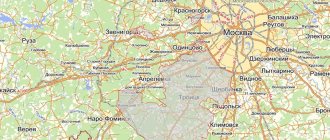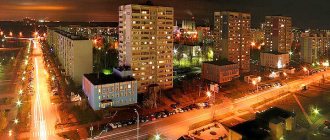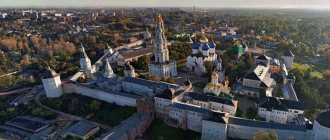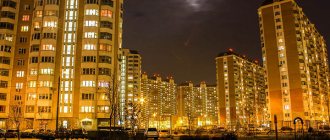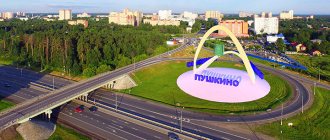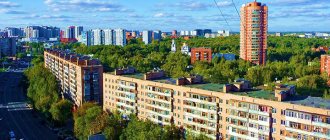General information about the city and a little history
The history of the appearance of the city is connected with the construction of the Moscow-Smolensk-Brest railway in the second half of the 19th century.
In 1872, at 41 versts, the Golitsynskaya station appeared - a wooden two-story building, a platform and several houses for service personnel - it became the beginning of a new village. The name was given in honor of the princely family - the Golitsyns, whose estate was located not far from the station. The lands belonging to the prince were actually divided by the railway, and at the dawn of the 19th century the owner decided to build a demonstration holiday village with the goal of selling the plots profitably in the future. The territory of the village south of the railway is cut through by 13 avenues, driveways and highways, and the village itself receives the name Golitsynsky town.
In the 1930s, Soviet writers chose Golitsyno as a place of creativity. In 1932, the small two-story house of F.A. Korsh was transferred to the Literary Fund and became the “house of creativity of the Writers’ Union.” Here, over the years, M. Aliger, K. Paustovsky, M. Shaginyan, A. Malyshkin, A. Gaidar, Musa Jalil, Mate Zalka, K. Trenev, A. Fadeev, A. Tvardovsky, V. Kataev rested and created their works. , E. Kazakevich. Anton Makarenko spent the last days of his life here. In the summer of 1937, after returning from emigration, the famous Russian writer Alexander Ivanovich Kuprin lived here. In the autumn of 1939 and winter of 1940, after a seventeen-year separation from her homeland, Marina Tsvetaeva lived in a room at one of the dachas in Golitsyn with her son Georgy. In Golitsyno there was a dacha of the poet and translator Arseny Tarkovsky.
In the post-war years, Golitsyno became a major industrial point. In 1949, the station was reconstructed and the railway tracks were electrified. In the fifties, a ceramic factory was created on the site of the seasonal fishing artel “Zvenigorodsky Trud”, which existed since 1928. Instead of an artel where toys, musical instruments, buttons and brooches were made, a hat factory arose.
Station, circa 1957
The first multi-storey buildings appeared in the village only in the 60s.
In 1972, the Higher Military-Political School of Border Troops of the KGB of the USSR was created on the territory of the village of Golitsyn, now it is the Golitsyn Border Institute of the FSB of Russia, one of the largest military universities in Russia.
By decree of the Governor of the Moscow Region dated September 9, 2004, the urban-type settlement of Golitsyno received the status of a city.
Golitsyno is located west of Moscow, at a distance of approximately thirty kilometers from the Moscow Ring Road. A highway known as the “Small Moscow Ring” runs along the northern outskirts of the city, and the Vyazemka River flows in the eastern part. The easiest way to get to the regional center - Odintsovo or Moscow - is by rail; trains run frequently; travel time to the center of Moscow is about 1 hour.
We're going by bus
The Golitsyno-Moscow route can be covered by bus, but there is a difficulty: there is no direct connection between these two cities, so you can take a bus to Lobnya, which passes through Moscow. The average travel time will be 1.5-2 hours. It is best to check the cost of the trip at the bus station ticket office, as it may vary depending on various factors.
You can also take advantage of other passing vehicles, but they do not stop at the local bus station, so you will have to literally catch them on the highway leading to Moscow. It is not possible to clarify the cost of travel on passing buses; calculations are made upon boarding. It is difficult to say whether traveling on such a vehicle will help you save time, because you will also need to wait for the bus.
Climate and ecology
The climate is “temperate continental”, winters are relatively mild, there are frequent thaws and melting snow underfoot.
Christmas tree on the station square. Photo by A. Zimin
The ecological situation in the city is good. The main sources of pollution are the Ceramic Plant, which has been operating at half capacity for the last decade, and vehicles.
Districts and real estate
Conventionally, Golitsino can be divided into four districts: “Nines”, “Keramika”, DRSU-4 and the private sector in the southern part of the city (the same Golitsyn town).
Map of Golitsyno districts
It should be noted that the city is still divided into two parts by the railway. There is no transport from one to the other, there is only one pedestrian bridge in the station area and “people's paths” across the railway tracks.
“Nines” is the youngest district, located in the northern part of the city. The first houses began to be built in the 70s and were nine stories high, hence the name. It is considered more favorable for living, since the station is located within walking distance of 5-10 minutes, and most residents work in neighboring cities. Also, the “nines” have their own kindergarten, school, clinic, banks, post office, shops and other conditions for a comfortable life. It is in the “nines” that the “Molodezhny” district is being built, where, at the very least, people from the old housing stock are being resettled.
Keramika was actively built up in the 60s, mainly with five-story buildings. The housing stock leaves much to be desired. The area is considered quite criminal. It is located 1.5 km from the station, you can get there by minibus or on foot, which is very risky, because... you have to go through the private sector, industrial enterprises or along railway lines, and the roads do not have sufficient lighting everywhere. In the area there are 2 kindergartens, a school, shops, and a gym. There is a large forest area on the border of the area.
View from Keramiki to Nyatki
DRSU-4 - southern outskirts of Golitsyno, old two-story houses built in the 50-60s. It does not have any infrastructure of its own; it is separated from Golitsyno station by private households.
South side of Golitsyno. Photo by Sasha Kallistova
Real estate in Golitsyno is expensive. In the northern part, a square meter on the secondary market costs around 100 thousand rubles, the primary one is much cheaper, about 80 thousand rubles. The southern part of the city is cheaper, as mentioned above, due to its distance from the station and older housing stock. Prices for two-room Khrushchev apartments there start at 3.5 million rubles.
How to get there
The end of the tourist route, behind the sign “End of the recreational facility”, begins the Dry Canyon, formed as a result of the earthquake. Here, high walls of limestone layers are revealed, and the bottom of the canyon itself was once covered by an ancient ocean called Tethys.
There are only two ways to get here:
- on foot;
- on an SUV.
It is not recommended to drive here in an ordinary passenger car. To the entrance of the canyon - yes, but not into the canyon itself. The road leading there is dirt, mostly washed out after rainfall and with fords. If you get to the “Kamenka-2” stop by car or bus, then it is better to walk for about 40 minutes, enjoying the surrounding beauty, and get into the canyon.
City infrastructure
All areas of Golitsyno suffer from a common problem - poor quality public services. We often see rusty water from the tap and untimely garbage disposal. However, the price of utilities remains high. So, for a two-room Khrushchev apartment with 2 registered residents you will need to pay about 5,000 rubles.
The clinic in Golitsyno is divided into 3 branches: one is in the “nines”, the second is in the “ceramics”, and the third is in the private sector. And if there are enough general practitioners in each branch, then narrow specialists are often “on duty” in only one of them 2-3 times a week for several hours. Moreover, the clinic also serves nearby rural settlements, which creates stable queues for appointments with any doctor and at any time. But there are paid clinics provided by all doctors. If nerves are more expensive, then you can get an appointment by paying about 1100-1600 rubles.
Kindergartens in Golitsyno are also inaccessible. The new development of the city without the accompanying social infrastructure is largely to blame.
The city is well stocked with grocery stores of various price categories and children's non-chain stores, but most residents prefer to go to Moscow shopping centers for clothes.
Zavodskoy Avenue (North side)
The main cultural object in the city is the cultural and leisure center. It is a theater, a cinema for children with their parents, and a venue for festive events. Everything is modest, but with soul, the events are budget-friendly and are often held free of charge. Lots of activities for children at very affordable prices. The only negative is the location in the southern part of the city, in the private sector, equidistant from populated areas. But some events organized by the Oktyabr CDC are held in the northern part of the city, at the library.
New Year's performance at the CDC October - 2015
Sports in the city are poorly developed. There are gyms, a sports and dance club, an amateur football club Dynamo Golitsyno, and a softball club "Kalita". There is a real need for a complex with a swimming pool, but, unfortunately, we can’t count on building one in the near future.
Location advantages
Golitsyno, located on the Small Moscow Ring, is reached by two highways: Minskoye and Mozhaiskoye, and within the city there is a railway station of the same name, and it is separated from Moscow by exactly 40 km. Not too much to cause big difficulties getting to work and home, but quite enough to isolate yourself from city noise and concrete dust.
New buildings in Golitsyno are being built according to a master plan that provides for the construction of places for recreation (swimming pool, cultural park, cinema), education (kindergartens, schools, secondary specialized educational institutions), and provision of medical services.
Enterprises and work
Large enterprises of the city are the Golitsyn Ceramic Plant, which produces bricks, road repair and construction department No. 19 (DRSU);
OJSC "Golitsyno-Instrument", which carries out wholesale and retail sales of professional tools, CJSC "Rodovoy Gerb" - the largest store of household goods, a warehouse complex.
The largest segment of city enterprises are small businesses. Their activities are focused on trade and providing services to the population.
Also in Golitsyno there are chain grocery stores “Perekrestok”, “Pyaterochka”, “Dixie” and points of sale of cellular operators.
From the northern part of the city it is easy and convenient to get to the industrial zone in the city. Bolshie Vyazemy. This is how enterprises such as Komus-Upakovka, the Korkunov Factory, and GOLAZ operate.
Unfortunately, wages in Golitsyno are average for the country and are approximately 20-25 thousand per month, so most city residents try to find employment in Moscow.
Is it far to go?
High variability is the main difference between the Moscow-Golitsyno route; the distance between the two cities ranges from 38 to 63 kilometers. It will depend on which highway you choose for your trip. The fastest way to get there is through Odintsovo and Zhavoronki, the distance will be 38 kilometers, the travel time will be significantly reduced, but you will have to drive along regional highways, which are not always comfortable.
If you travel by train, in this case the distance is strictly fixed and is 44 kilometers, but it should be taken into account that we are talking about the station route. “Moscow-Belorusskaya” - Golitsyno, electric trains run between these points. The average travel time is about an hour, it will depend on the vehicle you choose.
